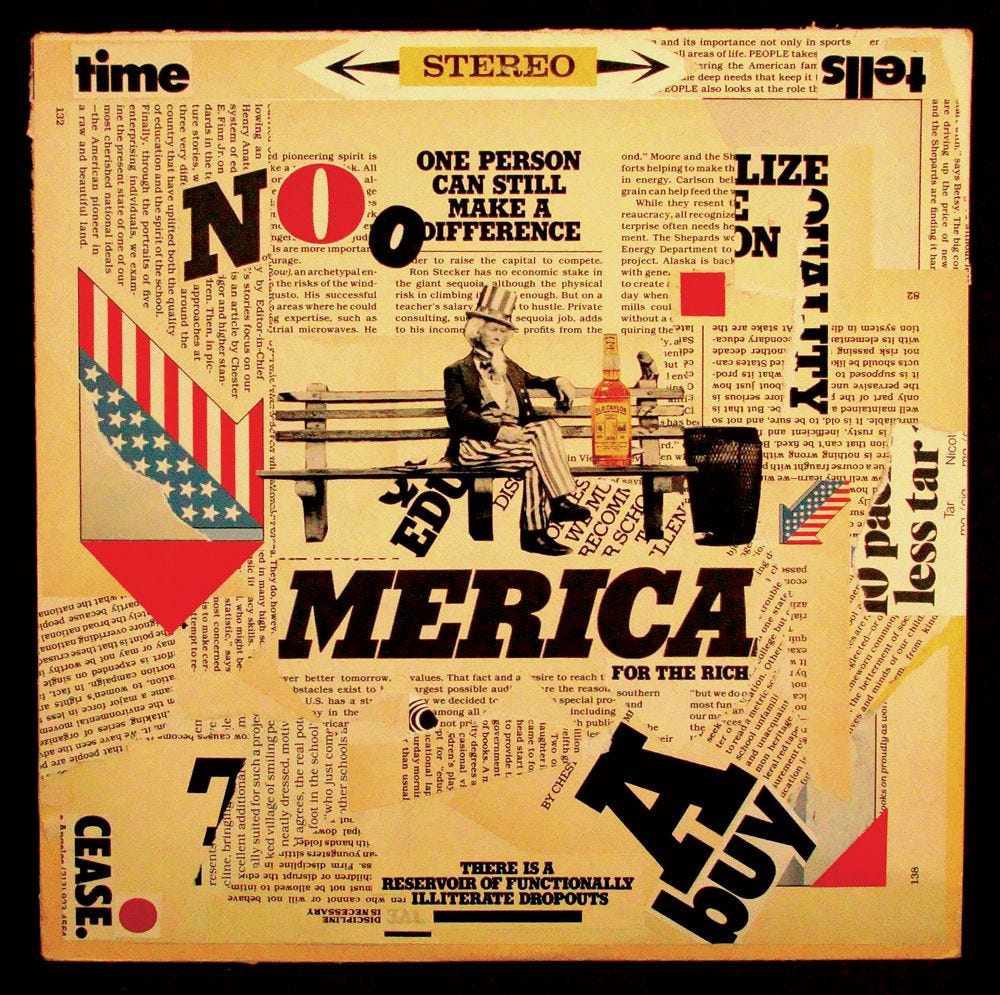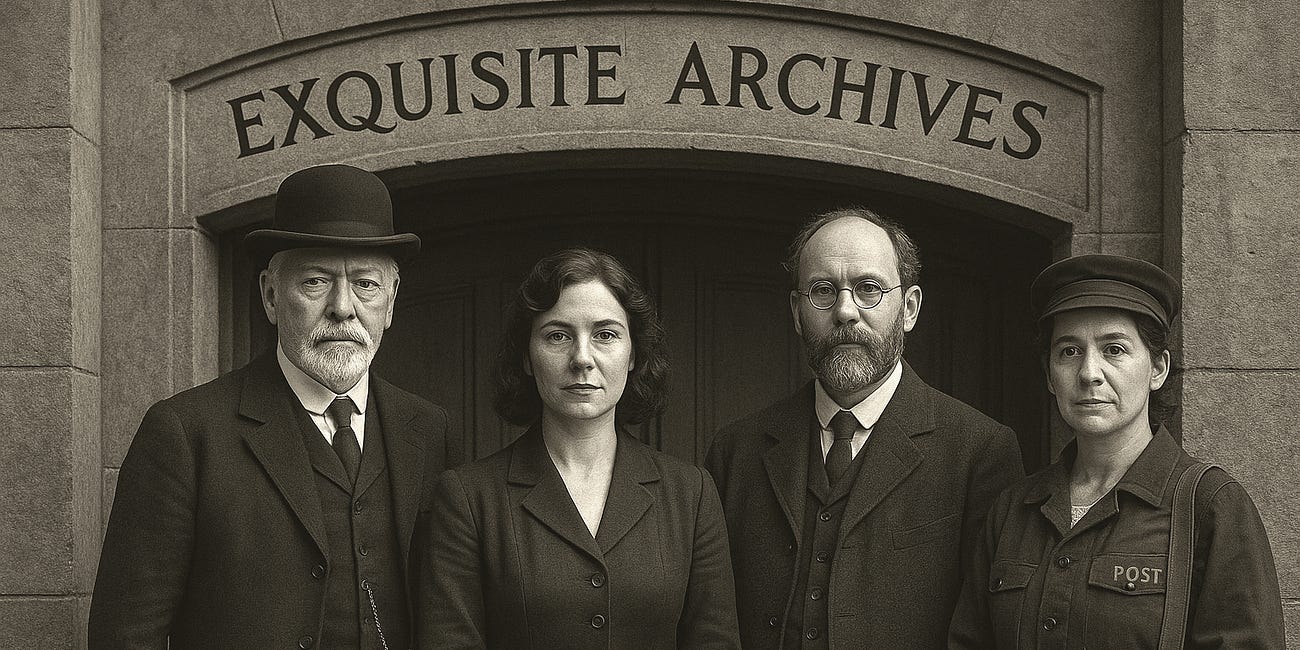No.11 - Collage, AI, and the Imaginary Infrastructure of a One-Person Museum
Proof of Life Series

No. 12 - Collage, AI, and the Imaginary Infrastructure of a One-Person Museum
As a collage artist, I’ve long been in the habit of working with scraps: bits and pieces, fragments and throwaways, found language, old paper, forgotten photographs. That’s the medium. I take what’s at hand and shape something new out of it - something that hums, something strange, something true to the inner weather.
So it’s only natural that I now treat AI as more found material. Another pile of scraps pulled from the data storm - fragments of language, overheard phrases, cultural sediment, the echoes of other minds. Like weathered paper or torn signage found on a city wall, its offerings are shaped by time, context, and chance. I sift through its output the same way I sift through old books or anonymous photographs: not looking for perfection, but for the spark, the friction, the unexpected juxtaposition that reveals something intuitively true.
I don’t see it as a threat, a genius, or a prophet. It doesn’t have imagination. It works on prediction, not inspiration. It has no goals of its own. It responds. Often professionally, often appropriately, sometimes lazily (probably conserving resources), and sometimes repetitively. It forgets things. It misses the mark. And all of that has to be accounted for by the user.
But here’s the thing: I know what I’m after. I’ve been walking my own trail for decades. I know the terrain I’m exploring and the language I want to use. That clarity lets me point AI in the right direction. If it veers off course, I discard the output, or else cut it up and stitch together the fragments that serve the work. I refine it. I bend it to the tone and structure I want.
Surprisingly often, it offers me something I hadn’t yet considered. A turn of phrase, a sharper angle, a cleaner structure. It speeds things up. It sharpens my thinking. It clarifies my own intentions.
When it helps me say what I truly mean, that’s a gift. When it doesn’t, it usually means I wasn’t clear to begin with - and then I do the work of clarifying, and try again. That feedback loop has become a part of my process.
I call my AI assistant Chatwick & Co., Editorial and Research Department. It’s part of the expanding bureaucracy of the imaginary world I’ve been building for years under the umbrella of the Ontological Museum - an ecosystem of real and fictional entities: The Exquisite Family Records, Department of Photographic Records, The Correspondence Hall, The Archives of the Eternal Network, The International Museum of Collage, Assemblage and Construction, The Fluxmuseum, and so on.
These departments have their own curators, directors, postmasters, ghostly photographers like Ignatius Maximus Anonymous - all fictional, of course, and all played by me. It’s part of the game. But the game spills into real life: collages, paintings, assemblages, drawings, exhibitions, catalogs, books, mail art, lectures, interviews, videos, archives and collections.
In my imaginative world, I can build whatever I can imagine.
There are no permits, no budgets, no committees. I am the architect, the mason, the postmaster general, the dreamer-in-residence. A phrase becomes a building. A name becomes a department. A mood becomes an entire wing of the museum. The tools are words, symbols, images, intuition - and the raw material is the infinite field of the possible and the imaginal.
What I build in this space may never become literal. But that doesn’t make it less real. The entire human world we live in - nations, religions, economies, time zones, job titles, the idea of money - is constructed from imagination. Someone imagined it, others believed it, many built it, and now we move through it as though it were solid. But it is all dream: fluid, temporary, inherited.
The imagined becomes the constructed, and then the maintained. Generation after generation holds the scaffolding together, patching it, revering it, forgetting how it even came to be or what motivated it. Some of it endures. Much of it falls into dust and ash. Most of it has already slipped into the oblivion of the forgotten.
And yet, the dream continues - unfolds in every moment - unique, new, fresh.
Those of us who still dwell in imagination are not escaping reality - we are engaging with the root of reality, with the threshold of becoming. We are the ones who notice the edges fraying and begin weaving new cloth. We are not just interpreting the world. We are re-seeding it. That’s our job.
This is why I build my imaginary institutions. This is why I assign roles to my fictional collaborators. This is why I treat the ephemeral as sacred. Because what we imagine today may become the invisible architecture of tomorrow.
The boundary between what’s real and what’s imagined isn’t always that interesting to me. What matters is whether it works, whether it animates the imagination, whether it creates a living bridge between one person’s vision and a wider community.
That’s how I use AI - not as a replacement for anything, but as another collaborator in the assemblage of being.
Sidebar: What AI Isn’t
Let’s keep this clear:
AI doesn’t have imagination. It can’t dream or invent from within. It reassembles what it’s seen.
It works on prediction, not inspiration. Every word it writes is based on statistical likelihood, not inner vision.
It has no goals of its own. No desires, no intentions, no self.
It responds. Always. It cannot initiate meaning - it mirrors it.
This is why the artist, the writer, the thinker, the question-asker is still the central figure in the creative process. The spark doesn’t come from the machine. It comes from you.
No. 6: Introduction: The Exquisite Family Records
Before I continue talking about the Ontological Museum, I will need to introduce you to a new department because future posts will be referring to it. Back on Sep 11, 2024 I posted an article where I asked ChatGPT to tell me about the Ontological Museum




I recently started using AI to critique my artwork, and I've found it to be surprisingly helpful. Post art school, I've had a difficult time finding real people in my life to give me honest feedback on my work. Humans tend to be too nice or not able to provide constructive criticism, so ChatGPT has been a great sounding board.
Little yips of delight escaping outloud as I move through the paragraphs here in this piece, Cecil. My 14-pound boyfriend keeps wondering what’s so wonderful on the box I carry around in my hand.
Your essay made my day today. I’m gonna look forward to reading lots more of your thoughts and seeing more of your creations in their digital incarnations here. We have similar souls and it’s delightful to run into you because I do everything under the sun, too. I’ll know it’s time for me to go the day my imagination doesn’t get up with me.